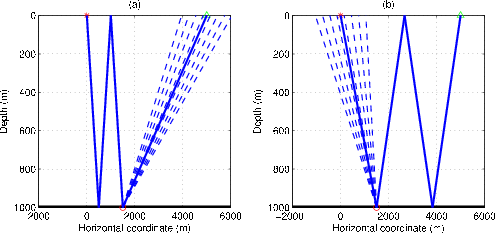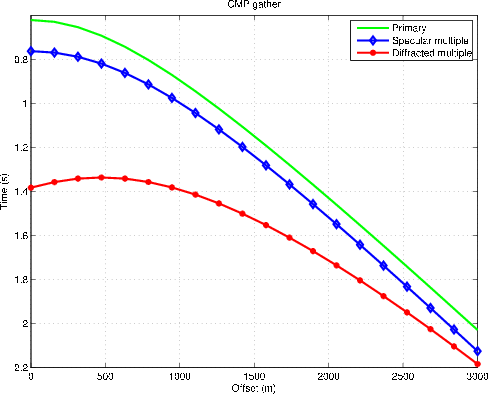Next: Data space and image
Up: Introduction
Previous: Introduction
There are many types of multiples, some of which are illustrated in Figure 1.
For the purpose of this thesis, however, multiples will
be classified in two main categories: specular multiples and diffracted
multiples. Specular multiples are those that reflect as light rays, following
Snell's law at the reflection points. Diffracted multiples, in contrast, are
scattered in all directions at the diffractor location. I will further classify
the diffracted first-order multiples into receiver-side and source-side multiples
depending on which side the diffractor lies as shown in panels (a) and (b) of
Figure 2 respectively. The dashed lines represent the arbitrary
trajectories that the multiple may take from the diffractor to the receiver (for
a receiver-side diffracted multiple) or from the source to the diffractor (for a
source-side diffracted multiple). The
travelpath from the diffractor to the receiver is independent of the
source location for a receiver-side multiple and likewise the travelpath from
the source to the diffractor is independent of the receiver location for a
source-side multiple. This behavior makes the kinematics of specular and
diffracted multiples very different in Common-midpoint (CMP) gathers.
Specular multiples have a moveout curve that is symmetric around their
apex at zero offset, since reciprocity requires the same traveltime for
rays from the source location to the receiver location and from the
receiver location to the source location. Diffracted multiples, on the other
hand, do not have their apex at zero offset (, ) and are therefore
not symmetric around zero offset as shown in Figure 3. The
travelpath of the receiver side multiple,
for example, is not the same if the source and receiver locations are
interchanged. Reciprocity is not violated, however. Receiver-side multiples
just become source-side multiples and vice-versa as illustrated in
Figure 2. A similar splitting of the source- and
receiver-side multiple happen with peg-leg multiples from a dipping reflector
(, ).

|
|---|
rays
Figure 1. Examples of 2D specular multiples.
|
|---|
![[pdf]](icons/pdf.png) ![[png]](icons/viewmag.png)
|
|---|

|
|---|
diffracted-muls-rays
Figure 2. Schematics of receiver-side (a) and source-side
(b) diffracted multiples. The asterisk represents the source and the triangle
represents a receiver. The dashed lines indicate possible trajectories of the diffracted
rays from the diffractor to the receiver or from the source to the diffractor. The
diffractor itself is indicated by the empty circle at about 1600 m.
|
|---|
![[pdf]](icons/pdf.png) ![[png]](icons/viewmag.png)
|
|---|
moveouts3
Figure 3. Comparison of the moveout curves of a primary,
a specular multiple and a diffracted multiple in a CMP gather. Notice that the apex
of the diffracted multiple is not at zero offset.
|

|
![[pdf]](icons/pdf.png) ![[png]](icons/viewmag.png)
|
|---|
Next: Data space and image
Up: Introduction
Previous: Introduction
2007-10-24


